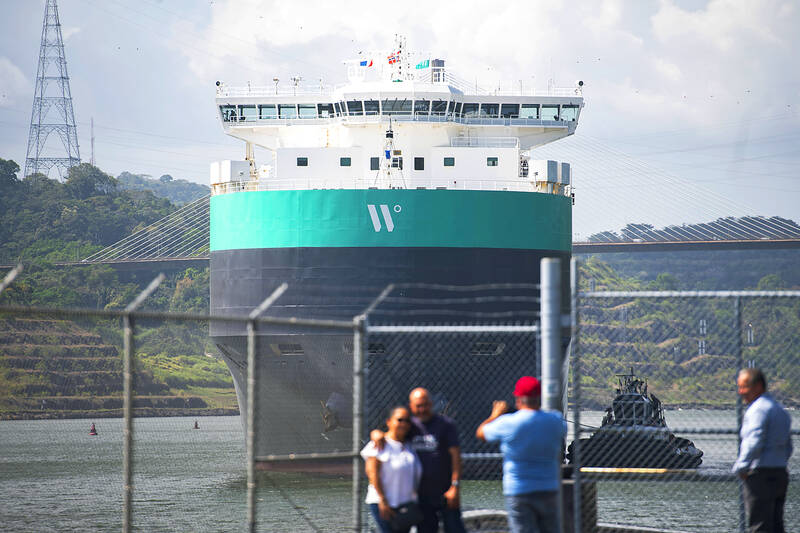A severe drought that began last year has forced authorities to slash ship crossings by 36 percent in the Panama Canal, one of the world’s most important trade routes.
The new cuts announced on Wednesday by Panamanian authorities are set to deal an even greater economic blow than previously expected and raise concerns about its affect on global trade.
Canal administrators now estimate that dipping water levels could cost them US$500 million to US$700 million this year, compared with previous estimates of US$200 million.

Photo: AP
On Wednesday, Panama Canal administrator Ricaurte Vasquez said daily ship crossings would be cut to 24 a day, compared with 38 in normal times last year.
Vasquez added that in the first quarter of the fiscal year the passageway saw 20 percent less cargo and 791 fewer ships than the same period the year before.
It was a “significant reduction” for the country, Vasquez said, but he added that more “efficient” water management and a jump in rainfall in November last year has at least enabled them to ensure that water levels are high enough for 24 ships to pass daily until the end of April, the start of the next rainy season.
Meanwhile, weather-related disruptions at ports in northern Europe and the diversion of vessels away from the Red Sea are causing “increased yard density” at container terminals, A.P. Moller-Maersk A/S said in an update to customers yesterday.
“Customers are kindly asked to pick up their units as soon as possible after discharge to support fluidity,” the company said.
Maersk and other shipping groups have diverted vessels away from the Red Sea and the Gulf of Aden following attacks by Yemen’s Houthis, sending them around the Cape of Good Hope rather than through the Suez Canal shortcut.
Additional reporting by Reuters

MULTIFACETED: A task force has analyzed possible scenarios and created responses to assist domestic industries in dealing with US tariffs, the economics minister said The Executive Yuan is tomorrow to announce countermeasures to US President Donald Trump’s planned reciprocal tariffs, although the details of the plan would not be made public until Monday next week, Minister of Economic Affairs J.W. Kuo (郭智輝) said yesterday. The Cabinet established an economic and trade task force in November last year to deal with US trade and tariff related issues, Kuo told reporters outside the legislature in Taipei. The task force has been analyzing and evaluating all kinds of scenarios to identify suitable responses and determine how best to assist domestic industries in managing the effects of Trump’s tariffs, he

‘SWASTICAR’: Tesla CEO Elon Musk’s close association with Donald Trump has prompted opponents to brand him a ‘Nazi’ and resulted in a dramatic drop in sales Demonstrators descended on Tesla Inc dealerships across the US, and in Europe and Canada on Saturday to protest company chief Elon Musk, who has amassed extraordinary power as a top adviser to US President Donald Trump. Waving signs with messages such as “Musk is stealing our money” and “Reclaim our country,” the protests largely took place peacefully following fiery episodes of vandalism on Tesla vehicles, dealerships and other facilities in recent weeks that US officials have denounced as terrorism. Hundreds rallied on Saturday outside the Tesla dealership in Manhattan. Some blasted Musk, the world’s richest man, while others demanded the shuttering of his

TIGHT-LIPPED: UMC said it had no merger plans at the moment, after Nikkei Asia reported that the firm and GlobalFoundries were considering restarting merger talks United Microelectronics Corp (UMC, 聯電), the world’s No. 4 contract chipmaker, yesterday launched a new US$5 billion 12-inch chip factory in Singapore as part of its latest effort to diversify its manufacturing footprint amid growing geopolitical risks. The new factory, adjacent to UMC’s existing Singapore fab in the Pasir Res Wafer Fab Park, is scheduled to enter volume production next year, utilizing mature 22-nanometer and 28-nanometer process technologies, UMC said in a statement. The company plans to invest US$5 billion during the first phase of the new fab, which would have an installed capacity of 30,000 12-inch wafers per month, it said. The

Taiwan’s official purchasing managers’ index (PMI) last month rose 0.2 percentage points to 54.2, in a second consecutive month of expansion, thanks to front-loading demand intended to avoid potential US tariff hikes, the Chung-Hua Institution for Economic Research (CIER, 中華經濟研究院) said yesterday. While short-term demand appeared robust, uncertainties rose due to US President Donald Trump’s unpredictable trade policy, CIER president Lien Hsien-ming (連賢明) told a news conference in Taipei. Taiwan’s economy this year would be characterized by high-level fluctuations and the volatility would be wilder than most expect, Lien said Demand for electronics, particularly semiconductors, continues to benefit from US technology giants’ effort